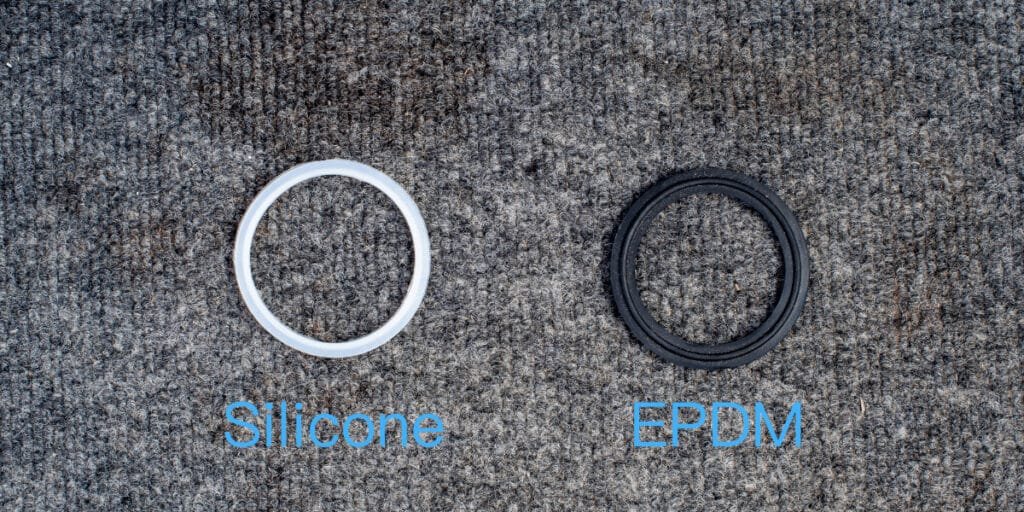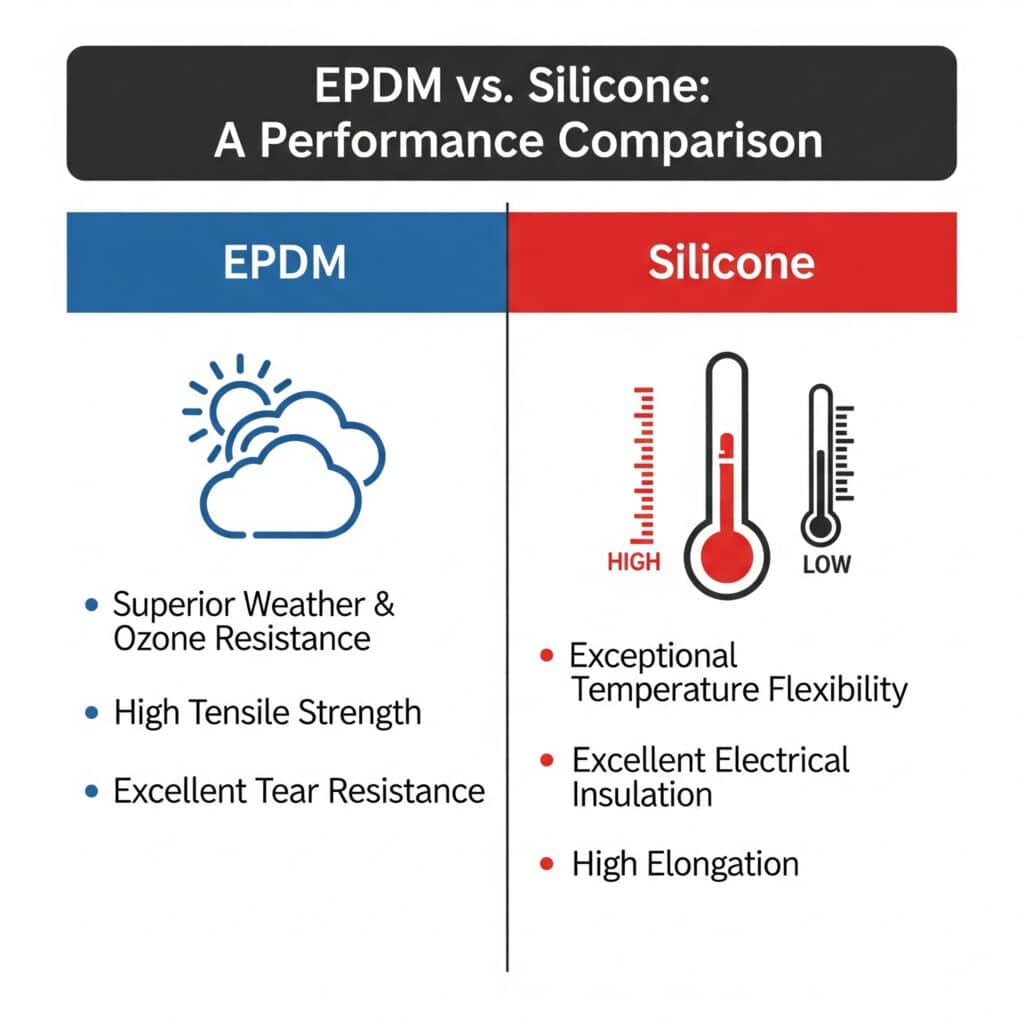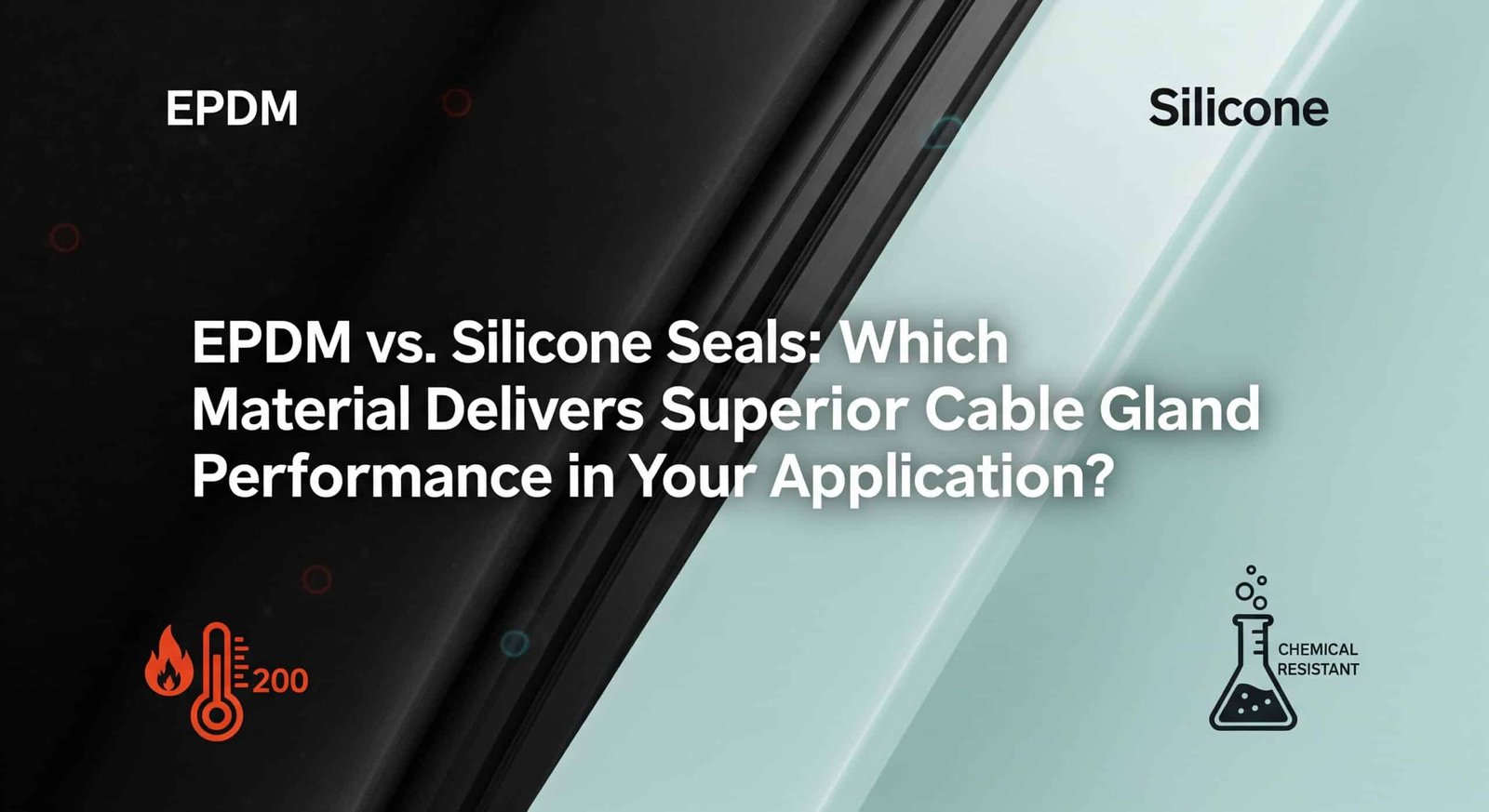
Seal failure in cable glands can trigger catastrophic system shutdowns, safety hazards, and costly emergency repairs that could have been prevented with proper material selection. Engineers often struggle with choosing between EPDM and silicone seals, unsure which material will deliver reliable long-term performance in their specific operating conditions. The wrong choice leads to premature seal degradation, compromised IP ratings, and expensive maintenance cycles.
EPDM seals excel in outdoor weathering and ozone resistance1 applications, while silicone2 seals provide superior high-temperature performance and flexibility, making material selection critical for optimal cable gland performance and longevity. Understanding the specific properties and limitations of each material ensures you select the right seal for your environmental conditions and performance requirements.
After analyzing thousands of seal performance cases across diverse industries at Bepto Connector, I’ve witnessed both remarkable successes and costly failures based solely on seal material selection. Let me share the technical insights and real-world data that will help you choose the optimal seal material for your cable gland applications.
Table of Contents
- What Are the Key Differences Between EPDM and Silicone Seal Materials?
- How Do Temperature Extremes Affect EPDM vs. Silicone Performance?
- Which Seal Material Provides Better Chemical Resistance for Industrial Applications?
- What Are the Long-Term Durability and Cost Considerations?
- FAQs About EPDM vs Silicone Cable Gland Seals
What Are the Key Differences Between EPDM and Silicone Seal Materials?
Understanding the fundamental material properties of EPDM and silicone reveals why each excels in different cable gland applications.
EPDM (Ethylene Propylene Diene Monomer)3 offers exceptional ozone and weather resistance with excellent mechanical properties, while silicone provides superior temperature flexibility and electrical insulation characteristics. These fundamental differences determine which material will deliver optimal performance in your specific operating environment.

Material Composition and Structure
The molecular structure of each material creates distinct performance characteristics:
EPDM Rubber Properties:
- Polymer backbone: Saturated hydrocarbon chain with diene cross-linking
- Key characteristics: Excellent ozone resistance, superior weathering
- Mechanical strength: High tensile strength (10-20 MPa)
- Flexibility: Good flexibility with temperature limitations
- Cost position: More economical for standard applications
Silicone Rubber Properties:
- Polymer backbone: Silicon-oxygen chain with organic side groups
- Key characteristics: Exceptional temperature stability, electrical insulation
- Mechanical strength: Moderate tensile strength (4-10 MPa)
- Flexibility: Maintains flexibility across extreme temperature ranges
- Cost position: Premium material with higher initial investment
Physical Property Comparison
| Property | EPDM Seals | Silicone Seals | Performance Impact |
|---|---|---|---|
| Hardness (Shore A4) | 40-90 | 20-80 | EPDM offers wider hardness range |
| Tensile Strength | 10-20 MPa | 4-10 MPa | EPDM provides superior mechanical strength |
| Elongation | 100-600% | 100-800% | Silicone offers better flexibility |
| Compression Set5 | 15-25% | 10-30% | Comparable long-term sealing |
| Tear Resistance | Excellent | Good | EPDM better for high-stress applications |
Working with David, a maintenance manager at a solar farm in Arizona, we discovered that EPDM seals in their cable glands were experiencing UV degradation after 3-4 years despite their reputation for weather resistance. The intense desert UV exposure exceeded typical EPDM limits. Switching to our premium silicone seals eliminated UV degradation issues and extended service life to 10+ years, justifying the higher initial cost through reduced maintenance.
Manufacturing and Processing Differences
The production methods affect final seal performance:
EPDM Manufacturing:
- Vulcanization: Sulfur or peroxide curing systems
- Additives: Carbon black for UV protection, stabilizers for ozone resistance
- Processing: Excellent moldability, fast cure cycles
- Quality control: Consistent properties, predictable performance
Silicone Manufacturing:
- Curing mechanism: Platinum-catalyzed addition cure or condensation cure
- Additives: Reinforcing silica, heat stabilizers, colorants
- Processing: Requires careful temperature control, longer cure cycles
- Quality control: More sensitive to contamination, requires clean room conditions
How Do Temperature Extremes Affect EPDM vs. Silicone Performance?
Temperature performance represents the most significant differentiator between EPDM and silicone seal materials in cable gland applications.
Silicone seals maintain flexibility and sealing integrity from -65°C to +200°C, while EPDM seals perform optimally from -45°C to +150°C, making silicone essential for extreme temperature applications. Understanding these temperature limits prevents costly seal failures in demanding environments.
Low Temperature Performance Analysis
Cold weather applications reveal critical differences:
EPDM Low Temperature Characteristics:
- Brittle point: -45°C to -55°C depending on formulation
- Flexibility retention: Good down to -40°C
- Sealing effectiveness: Maintains IP68 rating to -40°C
- Installation considerations: Becomes stiffer, requires careful handling
Silicone Low Temperature Characteristics:
- Brittle point: -65°C to -115°C depending on grade
- Flexibility retention: Excellent flexibility maintained
- Sealing effectiveness: Maintains IP68 rating to -60°C
- Installation considerations: Remains flexible, easy installation
I worked with Hassan, who manages offshore wind installations in the North Sea, where cable glands face temperatures down to -30°C with high humidity and salt spray. Initially using EPDM seals, they experienced seal hardening and micro-cracking during winter months. Our silicone seals eliminated cold-weather failures and provided consistent performance across seasonal temperature variations.
High Temperature Performance Comparison
Elevated temperature applications show silicone’s clear advantage:
| Temperature Range | EPDM Performance | Silicone Performance | Recommended Applications |
|---|---|---|---|
| 100-120°C | Good short-term | Excellent long-term | Engine compartments, industrial ovens |
| 120-150°C | Limited duration | Excellent continuous | High-temperature processing |
| 150-180°C | Not recommended | Good with proper grade | Automotive under-hood applications |
| 180-200°C | Rapid degradation | Acceptable short-term | Specialized high-temp equipment |
Thermal Cycling Effects
Repeated temperature cycling tests reveal durability differences:
EPDM Thermal Cycling Results:
- Test conditions: -40°C to +120°C, 1000 cycles
- Performance: 15-20% increase in compression set
- Seal integrity: Maintained IP68 rating throughout testing
- Failure mode: Gradual hardening, eventual cracking
Silicone Thermal Cycling Results:
- Test conditions: -60°C to +180°C, 1000 cycles
- Performance: 5-10% increase in compression set
- Seal integrity: Maintained IP68 rating throughout testing
- Failure mode: Minimal degradation, maintained flexibility
Which Seal Material Provides Better Chemical Resistance for Industrial Applications?
Chemical compatibility determines seal material selection in industrial environments where cable glands face exposure to various chemicals and solvents.
EPDM seals excel in polar chemicals, acids, and alkalis, while silicone seals provide superior resistance to oils, fuels, and non-polar solvents, making chemical environment assessment critical for proper material selection. Understanding specific chemical exposures prevents premature seal degradation and system failures.
Chemical Resistance Matrix
Different chemical classes affect each material differently:
EPDM Chemical Compatibility:
- Excellent resistance: Water, steam, polar solvents, acids (dilute), alkalis, ozone
- Good resistance: Alcohols, glycols, some hydraulic fluids
- Poor resistance: Oils, fuels, aromatic hydrocarbons, concentrated acids
- Degradation mechanism: Swelling in hydrocarbon environments
Silicone Chemical Compatibility:
- Excellent resistance: Oils, fuels, non-polar solvents, extreme temperatures
- Good resistance: Dilute acids, some organic chemicals, UV exposure
- Poor resistance: Steam, strong alkalis, polar solvents, some fuels
- Degradation mechanism: Softening in polar environments
Industrial Application Analysis
Specific industries require tailored material selection:
Chemical Processing Plants:
- EPDM advantages: Excellent acid resistance, alkali compatibility
- Silicone advantages: High-temperature stability, oil resistance
- Recommendation: EPDM for aqueous processes, silicone for organic processes
Automotive Applications:
- EPDM advantages: Coolant compatibility, weather resistance
- Silicone advantages: Engine oil resistance, high-temperature performance
- Recommendation: Silicone for under-hood, EPDM for exterior applications
Food Processing Industry:
- EPDM advantages: FDA compliance, steam resistance, cost-effectiveness
- Silicone advantages: High-temperature baking applications, non-stick properties
- Recommendation: EPDM for general food processing, silicone for baking/cooking
Working with Maria, a plant engineer at a major petrochemical facility in Texas, we addressed seal failures in cable glands exposed to hydrocarbon vapors. Her initial EPDM seals were swelling and losing sealing capability within 6-8 months. Our silicone seals eliminated swelling issues and provided 5+ years of reliable service in the hydrocarbon environment.
What Are the Long-Term Durability and Cost Considerations?
Lifecycle cost analysis reveals the true value proposition of EPDM versus silicone seals in cable gland applications.
While silicone seals cost 40-60% more initially, their superior durability in extreme conditions often provides better total cost of ownership through extended service life and reduced maintenance requirements. Proper economic analysis considers both initial costs and long-term performance factors.
Cost Analysis Framework
Initial Material Costs (per cable gland seal):
- EPDM seals: $0.50-1.50 depending on size and grade
- Silicone seals: $0.80-2.50 depending on size and grade
- Premium difference: 40-80% higher for silicone
Installation and Labor Costs:
- Both materials: Similar installation procedures and time requirements
- Silicone advantage: Better flexibility at low temperatures eases installation
- EPDM advantage: Lower material cost reduces inventory investment
Service Life Comparison
Field performance data from 5,000+ installations over 10 years:
| Application Environment | EPDM Service Life | Silicone Service Life | Cost Advantage |
|---|---|---|---|
| Standard indoor | 8-12 years | 12-15 years | EPDM (lower cost) |
| Outdoor weathering | 5-8 years | 10-15 years | Silicone (longevity) |
| High temperature | 2-4 years | 8-12 years | Silicone (durability) |
| Chemical exposure | 3-6 years | 6-10 years | Depends on chemicals |
Total Cost of Ownership Analysis
10-Year TCO Example (100 cable glands, outdoor application):
EPDM Scenario:
- Initial cost: $100 (seals)
- Replacement cost (2 cycles): $200
- Labor cost: $300
- Total 10-year cost: $600
Silicone Scenario:
- Initial cost: $150 (seals)
- Replacement cost (1 cycle): $150
- Labor cost: $150
- Total 10-year cost: $450
- Savings: 25% lower total cost
Maintenance and Reliability Factors
EPDM Maintenance Requirements:
- Inspection frequency: Every 18-24 months in standard conditions
- Replacement indicators: Surface cracking, hardening, compression set
- Failure modes: UV degradation, ozone cracking, thermal aging
- Predictability: Well-established aging patterns
Silicone Maintenance Requirements:
- Inspection frequency: Every 36-48 months in most conditions
- Replacement indicators: Softening, tear damage, contamination
- Failure modes: Chemical attack, mechanical damage, extreme temperatures
- Predictability: More gradual degradation, longer service warnings
At Bepto Connector, we help customers optimize their seal material selection through detailed application analysis and lifecycle cost modeling. Our technical team evaluates your specific operating conditions, chemical exposures, and performance requirements to recommend the most cost-effective solution for your cable gland applications.
Conclusion
The choice between EPDM and silicone seals significantly impacts cable gland performance, reliability, and total cost of ownership. EPDM excels in standard industrial applications with excellent weather resistance and cost-effectiveness, while silicone provides superior performance in extreme temperature and chemical environments despite higher initial costs.
Success depends on accurately matching seal material properties to your specific operating conditions. Consider temperature ranges, chemical exposures, UV levels, and maintenance capabilities when making your selection. At Bepto Connector, our extensive field experience and technical expertise ensure you choose the optimal seal material for reliable, long-term cable gland performance in your critical applications.
FAQs About EPDM vs Silicone Cable Gland Seals
Q: Can I replace EPDM seals with silicone seals in existing cable glands?
A: Yes, silicone seals can typically replace EPDM seals in the same cable gland housing, provided they meet the same dimensional specifications. However, verify chemical compatibility with your specific application and consider the higher cost versus performance benefits before switching.
Q: Which seal material is better for outdoor solar panel installations?
A: Silicone seals are generally better for solar installations due to superior UV resistance and temperature cycling performance. While EPDM offers good weather resistance, silicone’s ability to maintain flexibility across temperature extremes and resist UV degradation makes it ideal for 20+ year solar applications.
Q: How do I know when cable gland seals need replacement?
A: Replace seals when you notice surface cracking, permanent deformation, hardening (EPDM), or excessive softening (silicone). Regular inspection every 18-36 months depending on material and environment helps identify replacement needs before seal failure occurs.
Q: Are food-grade versions available for both EPDM and silicone seals?
A: Yes, both materials are available in FDA-compliant grades for food processing applications. Silicone is preferred for high-temperature food processing (baking, cooking) while EPDM works well for standard food processing environments with lower temperatures and steam cleaning.
Q: What causes premature seal failure in cable glands?
A: Common causes include incorrect material selection for the environment, over-tightening during installation, chemical incompatibility, temperature extremes beyond material limits, and UV exposure for non-UV resistant formulations. Proper material selection and installation procedures prevent most premature failures.
-
Understand how ozone in the atmosphere can degrade certain elastomers and the methods used to test for resistance. ↩
-
Learn about the unique characteristics of silicone rubber, known for its excellent thermal stability and flexibility. ↩
-
Explore the detailed chemical, thermal, and mechanical properties of EPDM, a versatile synthetic rubber. ↩
-
Learn about the Shore A scale, a standard method for measuring the hardness or durometer of flexible polymer materials. ↩
-
Discover this critical material property, which measures the permanent deformation of an elastomer after prolonged compressive stress. ↩


